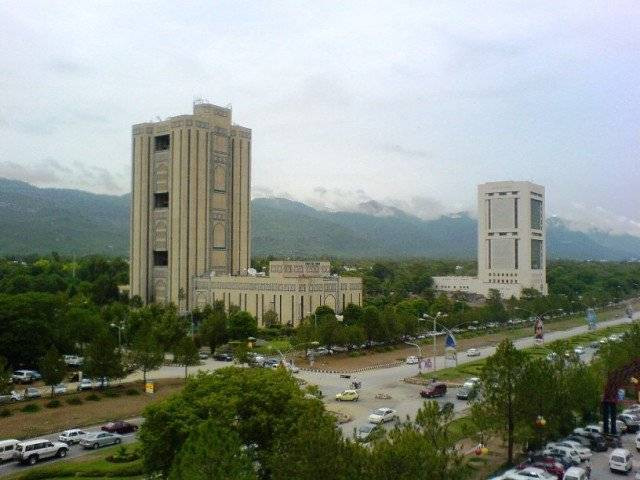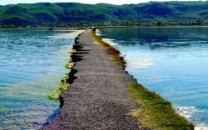Master plan: The Gordian Knot of Islamabad
With no review in 58 years, experts now wonder if it is even possible now to rework the federal capital’s master plan

PHOTO: EXPRESS/FILE
They termed the buildings present right in the heart of the capital “stains on the Master Plan,” and added that while the plan focuses on CPEC, it should also be kept in mind that by 2040, the population of Islamabad – per an estimate – will be more than 5 million.
CDA to build ‘protected U-Turn’ at Rawal Dam Chowk
Despite being considered one of the most beautiful federal capitals in the world, Islamabad’s master plan could not be reviewed in the last 58 years due to a lack of interest shown by previous governments. The outdated plan – which is currently in place – completed its tenure in the 1980s after which it was not reviewed. As a result of disorganisation and the absence of feasible planning, people living in low-income areas and slums of the capital are deprived of basic necessities, including education, health facilities, electricity and gas, among others.
There are only two big hospitals in the city to provide services to more than two million people. Similarly, the availability of educational facilities in the city is far from satisfactory. There are only 462 state-owned schools in Islamabad to accommodate 125,000 students who attend public schools. The remaining 250,000 schoolchildren are enrolled in private schools.
According to the existing CDA laws, schools cannot be opened in residential areas, however, some 400 private schools are running in prohibited areas. Planners forgot to include district courts in the master plan and, even after five decades, no permanent courts could be built. As a result, temporary courts have been running to date irrespective of the infrastructural problems that they create.
What’s more, there are more than 100 illegal housing schemes operating in Islamabad and when The Express Tribune asked experts about the resolution of the long-standing issues, they said that measures must be adopted to streamline the housing schemes that are spread across the landscape of Islamabad. They also added that measures should be adopted to address the issue of illegal settlements and a policy must be in place to streamline slums so that their residents can have access to basic necessities.
Talking to The Express Tribune, the Federal Commission Secretary and Director Master Planning, Zafar Iqbal Zafar, said that for the new Master Plan of Islamabad, the fourth meeting of the federal commission was called on February 21.
“We discussed the need to hire the services of consultants and create Terms of References (ToRs) to determine areas where research is required,” Zafar explained. “[In the upcoming meetings], the sub-committees will present their suggestions, after which we will consult town planners, private housing schemes and other stakeholders.”
Zafar further detailed that for the identification of issues that the city is currently facing, more than 15 studies – ranging from housing, transport, environment, solid waste management, water, education, health, geology, base map, and infrastructure – will be needed.
“The committees will review zoning regulations, building By-Laws, housing schemes regulations, commercialisation and acquisition and land disposal,” he added. “Not only that, but public opinion will also be considered before devising the new plan for which locals will be invited to Pak-China Friendship Center or Convention Center.”
Speaking on the matter, Prime Minister’s special advisor for CDA, Ali Nawaz Awan, said that the absence of a master plan since the 1960s speaks volumes about the incompetence and failure of the previous governments.
CDA demolishes illegal structures in Malpur
“During the tenure of Pakistan Peoples Party, some amendments were introduced in the Master Plan to benefit certain people,” Awan said. “Islamabad’s landscape is based on sectors comprising 20 union councils where there is an acute dearth of facilities. People bought properties and build their homes themselves as there was no mechanism to in place to get a map approved by the CDA.”
Awan further explained that the new plan has suggestions related to new hospitals and schools and there are also plans to ensure the provision of adequate water supply throughout the city.
“The new plan has made suggestions to take the federal capital towards regularisation, however, the final decision lies with the commission,” he said. “Before coming into power, we promised to build modern villages for people, and for that, international consultants will be hired through advertisements.”
Awan also shed light on the difficulties of temporary court buildings and said that the Islamabad High Court building is in its last phase of renovation, after which the issue will be resolved.
He also added that the government will continue to take action against the mafia that has been destroying Islamabad’s beauty for a long time.
When approached, Chief Commissioner Islamabad, Amir Ali Ahmed, said that when the first Master Plan was created, the issues didn’t surface. However, at present, the commission is fully aware of all the issues.
“Unfortunately, the Master Plan hasn’t been reviewed in decades, therefore, the aim of the new plan is to facilitate locals and rebuild Islamabad in line with the UN’s Sustainable Development Goals,” he said.
He added that apart from addressing big issues like water shortage, housing and inadequate traffic system, the new plan will also ensure that the capital remains as green as possible.
“Since the current Master Plan could not be implemented in a few sectors in the city and they are now part of Rawalpindi, we are making efforts to withdraw the green areas from the occupation of mafia.”
Published in The Express Tribune, April 2nd, 2019.


















COMMENTS
Comments are moderated and generally will be posted if they are on-topic and not abusive.
For more information, please see our Comments FAQ